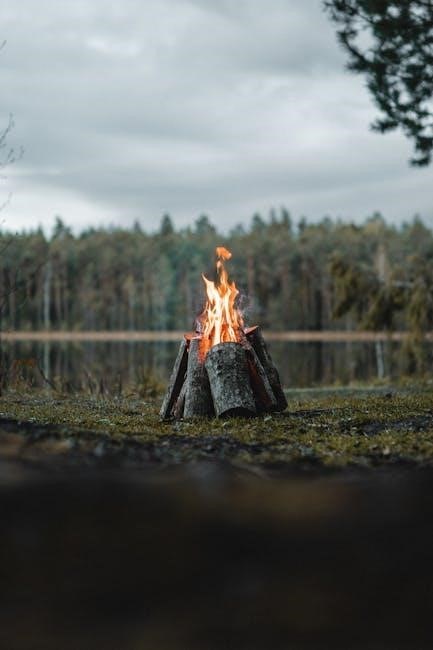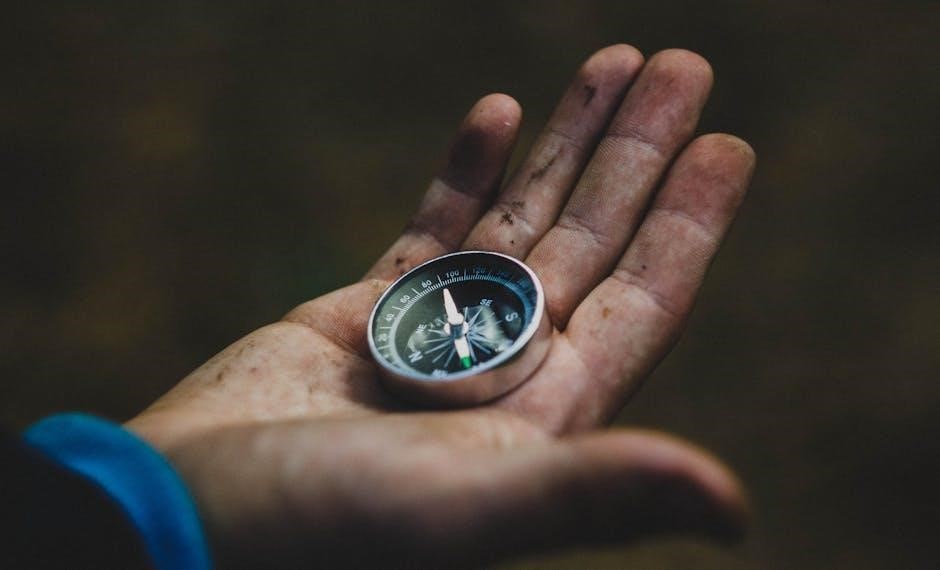
survival guides
Survival guides are essential resources, offering crucial information and techniques for navigating challenging situations․ They equip individuals with the knowledge to secure basic needs like shelter, water, and food, while also providing guidance on signaling for help․

Core Survival Skills
Mastering core survival skills is paramount for ensuring safety in unforeseen circumstances․ These abilities encompass fire starting for warmth and cooking, water purification to avoid dehydration, shelter construction for protection from the elements, and foraging for food, sustaining life in the wild․
Fire Starting Techniques
Initiating a fire is a foundational survival skill, offering warmth, light, and the ability to cook food and purify water․ Mastering various fire-starting techniques is crucial, especially when faced with adverse weather conditions․ The bow drill method, while challenging, provides a reliable spark source by friction․ Hand drill is another option․
Flint and steel, or ferrocerium rods paired with a striker, are popular choices for their dependability․ Gathering tinder, such as dry leaves, birch bark, or bird nests, is essential for catching the initial spark․ Creating a tinder bundle and gradually adding larger pieces of wood ensures a sustainable flame․
Consider using a magnifying glass to concentrate sunlight onto tinder․ Practice these techniques, in your backyard, in different environments to enhance your proficiency․ Remember safety precautions, such as clearing the area around the fire and having water or sand nearby to extinguish it․ Fire can be your best friend․
Water Purification Methods
Securing potable water is paramount for survival; dehydration poses a severe threat․ Various water purification methods exist to eliminate harmful bacteria, viruses, and parasites․ Boiling water for at least one minute effectively kills most pathogens, rendering it safe to drink․ Always let water cool down after boiling․
Chemical treatments, using iodine tablets or chlorine dioxide, are convenient options, especially when fire is not feasible․ Follow the manufacturer’s instructions carefully to ensure proper dosage and effectiveness․ Filtration systems, ranging from portable pumps to gravity-fed filters, remove sediment and microorganisms․
Constructing a makeshift filter using layers of cloth, charcoal, sand, and gravel can also improve water quality․ Always choose water sources carefully, avoiding stagnant pools or areas with obvious contamination․ Consider collecting rainwater or dew as a relatively pure source․ Prioritize water purification to prevent illness and maintain optimal health in survival scenarios․
Shelter Construction
Building a shelter is a crucial survival skill, providing protection from the elements and maintaining body temperature․ The type of shelter depends on available resources and the environment․ A lean-to, constructed with a sturdy frame and covered with branches, leaves, or debris, offers basic protection from wind and rain․
Debris huts, built by piling up organic materials, provide insulation against cold temperatures․ Natural shelters, such as caves or rock overhangs, can be improved for added protection․ Consider the location of your shelter, avoiding areas prone to flooding or landslides․ Prioritize insulation, using layers of leaves or other materials to trap heat․
A well-constructed shelter can significantly increase your chances of survival in harsh conditions․ Remember to consider size, materials, and immediate dangers when choosing a location and building your shelter․ A shelter is a vital part of staying alive in the wild․
Food Procurement in the Wild
Finding food in the wild is a critical aspect of survival, requiring knowledge of edible plants and basic hunting techniques․ Prioritize identifying safe and nutritious food sources to maintain energy levels․ Learning to recognize edible plants is essential, but always exercise caution and avoid consuming anything you are not 100% sure about․
Insects can be a valuable source of protein, but ensure they are properly cooked to eliminate parasites․ Small game hunting, using snares or traps, can provide a more substantial food source․ Fishing with improvised tools is another option, depending on the availability of water sources․
Conserving energy while foraging is crucial, focusing on easily accessible and abundant food sources․ Remember to respect the environment and avoid over-harvesting․ By understanding the local ecosystem and employing effective procurement strategies, you can increase your chances of survival in the wild․ Always boil your water to kill parasites before consuming as well․
Essential Gear and Kits
A well-prepared survival kit is paramount for increasing your odds in emergency situations․ These kits should include items catering to basic survival needs: shelter, fire, water, food, and first aid․ A sturdy knife is indispensable for various tasks, from shelter construction to food preparation․ Fire-starting tools, such as lighters, waterproof matches, and ferro rods, are vital for warmth, cooking, and signaling․
Water purification methods, like water filters or purification tablets, are crucial for obtaining safe drinking water․ A first-aid kit should contain essential medical supplies to address injuries and prevent infections․ High-calorie food rations provide sustenance when foraging is not immediately possible․ A signaling device, such as a whistle or signal mirror, can significantly improve your chances of rescue․
Navigation tools, including a map and compass, are essential for staying oriented and finding your way to safety․ Consider customizing your kit based on your environment and potential hazards․ Regularly inspect and maintain your kit to ensure everything is in working order․

Survival Hacks and Tricks
Survival hacks utilize resourcefulness and ingenuity to overcome challenges with limited resources․ These tricks offer creative solutions for everyday problems, from fire starting to shelter building, improving your chances of survival in unexpected wilderness scenarios and emergencies․
Improvised Tools and Solutions
In survival situations, resourcefulness is key․ When conventional tools are unavailable, the ability to improvise can be life-saving․ This involves creatively repurposing found objects and natural materials to create functional tools and solutions․ For example, a sharp rock can become a knife, and sturdy branches can be crafted into a makeshift shelter frame․
Understanding the principles of leverage, friction, and material strength is crucial for successful improvisation․ Learn to identify useful plants for cordage or medicinal purposes․ A hollow log can be used to transport water or a makeshift container․
The ability to adapt and problem-solve using the environment is a hallmark of a skilled survivor․ By practicing these skills, you’ll be better prepared to face unexpected challenges and increase your chances of survival․ Remember, observation and a willingness to experiment are your greatest assets․
Psychological Aspects of Survival
Survival situations demand mental fortitude․ Maintaining a positive attitude, managing fear, and staying focused are crucial․ Psychological resilience significantly impacts decision-making and the ability to persevere through adversity, ultimately influencing survival outcomes․
Maintaining Calm and Focus
In a survival scenario, panic is a dangerous enemy․ The ability to maintain calm and focus is paramount to clear thinking and effective decision-making․ Techniques for managing stress, such as deep breathing exercises and mindfulness, can be invaluable tools․ A calm mind allows for a rational assessment of the situation, prioritization of needs, and the development of a sound survival strategy․
Focus helps to concentrate on immediate tasks like finding water or building shelter․ Avoid dwelling on the enormity of the situation․ Break down larger goals into smaller, manageable steps to maintain a sense of accomplishment and progress․ Remember the importance of positive self-talk and visualizing success․ These mental exercises can bolster confidence and resilience when faced with seemingly insurmountable odds․ A clear, focused mind is a survival asset․
Mental clarity also aids in the effective use of survival skills․ A panicked individual might waste resources or make poor choices, while a calm person can conserve energy, apply knowledge, and adapt to changing conditions with greater efficiency․ Focus on the present moment, and trust your abilities and training․

Signaling for Help
Effective signaling is a critical skill in any survival situation, as it significantly increases the chances of rescue․ The primary goal is to attract attention to your location, using visual or auditory methods that can be detected from a distance․ Understanding various signaling techniques and having the means to execute them is vital․
Visual signals include using mirrors to reflect sunlight, creating large signal fires, or laying out ground-to-air signals with brightly colored materials․ Fires should produce thick smoke, achievable by adding green vegetation or rubber to the flames․ Ground signals should be large and easily recognizable from the air, such as an “SOS” or a large arrow pointing in your direction of travel․ Auditory signals, like whistles, can carry over long distances and are especially useful in dense terrain․
The key to successful signaling is persistence and visibility․ Choose a high, open location to maximize the range of your signals․ Repeat your signals regularly, especially during daylight hours and periods of increased air traffic․ Conserve your energy and resources, but don’t give up on signaling until help arrives․

Advanced Survival Strategies
Beyond the core survival skills lie advanced strategies that can significantly improve your chances of long-term survival in challenging environments․ These techniques often involve a deeper understanding of the natural world, resourcefulness, and the ability to adapt to changing circumstances․ Mastering these strategies can transform a basic survival scenario into a more sustainable existence․
One key aspect is advanced foraging, which involves identifying and utilizing a wider range of edible and medicinal plants and insects․ This requires extensive knowledge of local flora and fauna, as well as the ability to process these resources safely․ Another important strategy is trapping and snaring, which can provide a reliable source of protein․ Building more permanent and insulated shelters, like earth shelters or log cabins, can offer greater protection from the elements․
Water management becomes critical in arid environments, requiring skills in collecting rainwater, dew, and even extracting water from plants․ Finally, developing navigation skills beyond basic map and compass work, such as celestial navigation, can enable you to travel long distances and locate resources or potential rescue points․ These advanced strategies, combined with resilience and a proactive mindset, are essential for thriving in the wilderness․